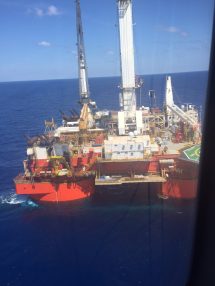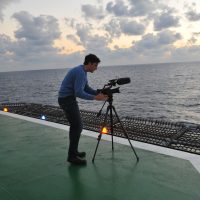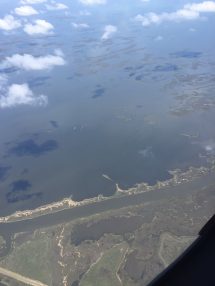To the Gulf … To the Future
May 11, 2017

This is the first post in a series on the Jackson School-led mission to drill for samples of methane hydrate from under the Gulf of Mexico for scientific study. Additional posts are linked at the end of the page.
Gulf of Mexico – 150 miles off the coast of Louisiana, a cadre of Jackson School scientists and students and colleagues from a handful of other institutions are working 24 hours a day to do something that has rarely been done before. The group, led by Professor Peter Flemings, is drilling into the seafloor more than a mile below them and trying to return cores of methane hydrate to the surface under pressure for analysis.
The project is part of an $80 million Department of Energy funded expedition. It’s big science. Important science. Methane hydrate is a little understood yet abundant substance with tremendous potential as a future energy source.
The DOE chose Flemings and UT to lead the project, putting the Jackson School firmly at the cutting edge of this developing science. When the cores – which should begin coming up over the next few days – eventually leave the rig, they will be analyzed and stored in the basement of the Jackson School in the newly built

pressurized coring center. That’s after the scientists aboard the Helix Q4000 conduct their initial analysis in a series of laboratories they have set up in shipping containers on the deck of the rig.
This drilling currently underway is a trial to test the technology and methods being pioneered to bring up samples of methane hydrate under the same pressure and temperature it is found under the gulf floor. If the technique fails and the cores depressurize on the way to the surface, the methane hydrate will disassociate or just bubble away.
The Jackson School sent myself and videographer Drew Ott to document the mission. The difficulty and expense of putting two communications professionals on a drilling rig in the Gulf – not to mention the headaches it poses to staff and crew – is not inconsequential. But Flemings and Dean Sharon Mosher thought it was important to help explain this vital scientific mission to the Jackson School community and the world at large.

Drew and I arrived on the Helix Q4000 Tuesday afternoon after spending weeks preparing. As it ends up, they don’t just let you board a drilling rig. The journey required three certifications and included training on how to survive a helicopter crash and being adrift at sea – skills we hope never to test!
You’ll be able to follow the scientific mission on this blog for the next few days, as schedule and internet connection allow. I also urge you to follow the blog being produced by members of the scientific team – the people doing the real work. Ultimately, we’ll produce a video on the project and, of course, a feature story in the Jackson School Newsletter. Both will be flush with visuals.
Anton Caputo, Jackson School Communications Director
May 12, 2017: Hitting Bottom and Beyond
May 13, 2017: Working the Bugs Out
May 14, 2017: Bingo!
May 16, 2017: Bleeding the Pressure
May 22, 2017: Bust to Boom
